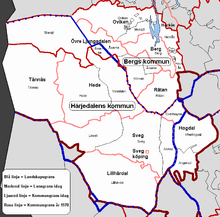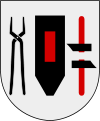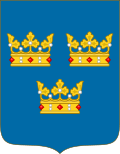Härjedalen
| Härjedalen | ||
|---|---|---|
| ||
 | ||
| Country | Sweden | |
| Land | Norrland | |
| Counties |
Jämtland County Dalarna County | |
| Area | ||
| • Total | 11,405 km2 (4,403 sq mi) | |
| Population (2009)[1] | ||
| • Total | 10,028 | |
| • Density | 0.88/km2 (2.3/sq mi) | |
| Ethnicity | ||
| • Language | Swedish, some Norwegian | |
| Culture | ||
| • Flower | Arctic violet | |
| • Animal | Bear | |
| • Bird | Golden eagle | |
| • Fish | Grayling | |
| Time zone | CET (UTC+1) | |
| • Summer (DST) | CEST (UTC+2) | |

Härjedalen (Swedish pronunciation: [ˈhærjəˈdɑːlən]; Norwegian: Herjedalen, pronounced [ˈhærjəˈdɑːlən]) is a historical province or landskap in the centre of Sweden. It borders the country of Norway as well as the provinces of Dalarna, Hälsingland, Medelpad, and Jämtland. The province originally belonged to Norway, but was ceded to Sweden in the Treaty of Brömsebro, 1645.
Administration
The traditional provinces of Sweden serve no current administrative or political purposes, but are historical and cultural entities. In the case of Härjedalen there is a municipality, kommun, Härjedalen Municipality, which is located in the southern part of Jämtland County. The municipality does not exactly correspond to the province, but is larger.
Heraldry
The arms is represented with a dukal coronet. Blazon: "Argent a Sledgehammer Sable with Core Gules between Tongs of the second and two Hammers adorsed in pale of the second handled Gules.". It was granted in 1660. Since 1974 Härjedalen Municipality uses the same coat of arms, but without the coronet.
Geography
Four-fifths of the province is situated above 500 metres of altitude, constituting a part of the Scandinavian mountain range. Sweden's highest village Högvålen, at 835 metres, is also within the province.
Härjedalen is strange in that there are no cities at all. The only village of even modest size is the market town Sveg, which used to be the administrive center of the province.
The provincial flower is the Arctic violet. It is prominent on high altitudes in Europe, and is also found in the Alps.
Sånfjället National Park extends through the municipality.
History
Jämtland and Härjedalen were originally provinces of Norway. Härjedalen came under the Norwegian king ca. 1100. After the Treaty of Brömsebro in 1645, Härjedalen, along with Jämtland, were ceded to Sweden. They were commonly spelled Herjedalen and Jemtland until 1660.
The first population of Härjedalen is estimated to have migrated here some 9,000 years ago. The population lived from hunting and fishing, close to the inland ice which by then had started to melt. Ruändan, in the Flatruet mountains in northwestern Härjedalen, is the location of a large site of rock paintings. The rock paintings at Ruändan consists of some twenty figures depicting people, bear, moose and reindeer. The rock paintings was first reported in 1896 and are estimated to be over 4000 years old.
According to one legend, Härjedalen is named after a powerful Norseman who had to flee east from the Norwegian court of king Halfdan Svarte after killing one of the king's men with a horn. Thereafter he was known as Härjulf Hornbrytare (lit. "Härjulf the Hornbreaker"). For a time he entered the service of the Svea King Anund, until he eloped with that king's sister, Helga, and together they disappeared into the remote location in the region eventually named after him. Today a statue stands dedicated to them in the village of Lillhärdal. Härjulf and Helga were the foreparents to the Icelander, Bjarni Herjólfsson, who was the first Norseman to see the "new world" when he was blown off-course whilst on a voyage to Greenland. His boat is the one Leif Eriksson acquired about 15 years later for Leif's famed landing on Vineland.[2]
A large portion of Härjedalen residents emigrated to America, principally to Northwestern Minnesota during the late 1800s.
Etymology

The name Härjedalen, from Old West Norse Herjárdalr, literally means the "Valley of the Härje river". A Latinized transliteration is Herdalia, although that name is hardly encountered in the English language today. More prominent are derivations such as Herjedalen or Haerjedalen. The more prosaic explanation of the name says that the word her or har just means "mound of stones" and refers to stones in the river Härjån.[3]
Subdivisions
Härjedalen was historically divided into districts.

Sports
Football in the province is administered by Jämtland-Härjedalens Fotbollförbund.
References
- ↑ Statistics Sweden Archived August 20, 2010, at the Wayback Machine.
- ↑ Härjulf Hornbrytare (Lillhärdals historia)
- ↑ Svenskt ortnamnslexikon 2003
| Wikimedia Commons has media related to Härjedalen. |
| Wikivoyage has a travel guide for Härjedalen. |
External links
- Municipality site
- Härjedalens Culture Center
- Jämtland Härjedalen Tourist site
- Härjedalen map
- Map of Härjedalen
Coordinates: 62°15′N 13°57′E / 62.250°N 13.950°E

